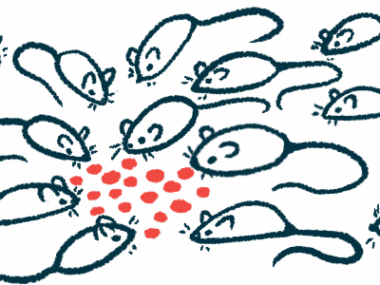Topical use of RCI001 prevents dry eye damage in Sjögren’s mouse model
Researchers note artificial tears have 'limited' effectiveness in patients
Written by |

Topical application of the experimental therapy RCI001 prevented dry eye damage and improved tear secretion in a mouse model of Sjögren’s disease, according to a new study.
Treatment in the mice also reduced markers of inflammation and oxidative stress, a type of cellular damage implicated in eye surface inflammation and dry eye disease.
“[RCI001] may be considered a novel therapeutic candidate for ocular surface inflammatory diseases, including dry eye in [Sjögren’s],” the researchers wrote. “If [the medication] is successfully developed, we believe [it] might be an effective and safe therapy … with broad-spectrum antiinflammatory/antioxidative effects.”
Their study, “Efficacy of RCI001 as a Therapeutic Candidate in a Primary Sjögren Syndrome Mouse Model,” was published in the journal Cornea.
Dry eye damage markedly reduced in mice after 1 week
In Sjögren’s disease, the immune system mistakenly attacks the glands that make tears and saliva. The resulting inflammation damages the glands, limiting the production of fluids that normally keep the eyes and mouth moist.
Treatments for dry eyes in Sjögren’s — also known as dry eye disease (DED) — include artificial tears, eye drops that increase tear production, and therapies that dampen the immune response.
“However, the limited efficacy of these agents and associated side effects have led to unmet medical needs in the treatment of DED,” the researchers wrote.
RCI001 is a treatment candidate for diseases, like DED, that affect the eye surface. Previous studies have shown it to suppress inflammation and oxidative stress.
To investigate its impact on DED related to Sjögren’s, researchers in South Korea applied RCI001 to the eyes of a Sjögren’s mouse model (NOD.B10). This model mimics the human disease in several ways, featuring both local and bodywide involvement.
The eyes of the mice were topically treated with RCI001 or a saline (salt) solution, twice daily for one week.
Before and then after treatment, the mice were assessed by measuring the level of tear secretions and ocular surface staining (OSS), in which a dye is applied to the eye surface to detect areas of eye surface damage. OSS scores were determined by the degree of staining in five zones on the eye surface — center, top, bottom, left, and right — with scores for each zone ranging from 0 to 3. Higher scores, up to 15 points, indicated more eye damage.
After one week of treatment, the average OSS scores were significantly lower in mice given RCI001 than in the animals given saline (5.9 vs. 8.4). With RCI001 treatment, OSS scores dropped from an average of 12.6 to 5.9 after one week. Saline drops also reduced average OSS scores from 11.9 to 8.4.
Tear secretion was significantly higher in the RCI001 group than in the saline group (4.2 vs. 3.7 mm) after one week. Still, tear secretion improved with RCI001 compared to before treatment (4.2 vs. 4.2 mm) but not saline (3.5 vs. 3.7 mm). No adverse events were noted in any of the mice.
Researchers investigate therapy’s mechanism of action
To assess RCI001’s mechanism of action, the researchers measured the production of pro-inflammatory immune signaling proteins and markers for oxidative stress in tissues of the lacrimal glands, which produce tears, as well as the conjunctiva and cornea. The conjunctiva covers the white part of the eye, and the cornea covers the iris and pupil.
RCI001 was found to significantly reduce the levels of interleukin-1-beta (IL-1-beta) and IL-17 in the conjunctiva and cornea compared with saline. Treatment with the experimental therapy also outperformed saline in lowering levels of IL-6 and IFN-gamma in lacrimal glands. While treatment reduced several other pro-inflammatory immune proteins in both tissues, the difference was not statistically significant.
With treatment, the production of oxidative stress markers NOX2 and NOX4 significantly decreased compared with saline in the conjunctiva and cornea but not in the lacrimal glands. When tissues were examined under a microscope, the RCI001 group showed significantly lower oxidative stress markers NOX4, 4-HNE, and HEL, but not NOX2.
Topical [RCI001] demonstrated a remarkable therapeutic effect on the inflammatory dry eye in [Sjögren’s].
Lastly, the team examined the impact of RCI001 on conjunctival goblet cells, which are lost in DED, including in Sjögren’s. This cell type secretes mucus onto the eye surface to maintain its wet environment. However, goblet cell counts did not significantly differ between the RCI001 and saline groups.
“Topical [RCI001] demonstrated a remarkable therapeutic effect on the inflammatory dry eye in [Sjögren’s] by improving clinical signs, modulating the inflammation in [conjunctiva and cornea] and [lacrimal glands], and reducing the oxidative stress of the ocular surface,” the researchers concluded.







